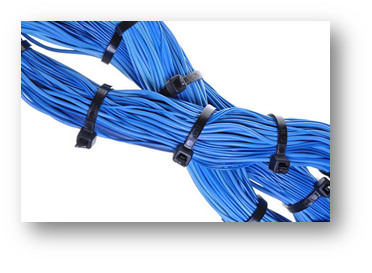To Bundle or Not Bundle?
February 5, 2019 / General, Industrial Networks, Best Practices
If you recently attended the BICSI Winter Conference in Orlando, picked up an industry publication or participated in a webinar, you’ve probably been exposed to plenty of information on PoE and its effect on cabling plants. By now, you may even be tired of hearing about heat rise in bundles of cables that are delivering remote power to devices and how this can cause insertion loss, degrade the cable and impact Ethernet transmission.
But despite all the talk about PoE and heat rise in bundles, whether to bundle or not to bundle remains the question for some. Thankfully, there’s a simple answer.
The First Bundling Issue
Do you remember back when Category 6A cabling was ratified to support 10 Gig Ethernet? One of the first things we learned about this cable type was that alien crosstalk had become a concern, and not bundling cables was one way to reduce that phenomena. In fact, standards bodies like TIA, ISO/IEC and BICSI, as well as most cable manufacturers, recommended letting Category 6A cables have a “natural lay” in pathways and to avoid overfilling conduits.
Despite the recommendations, many installers continued to deploy neatly bundled cables to showcase their neat work and please the customer. For high-performing Category 6A cables with innovative designs that reduced alien crosstalk, bundling also proved to not be a significant concern. And thankfully alien crosstalk testing is easy with your Fluke Networks’ DSX CableAnalyzer copper cable certifier.

The Latest Bundling Issue
Enter advanced Type 3 and Type 4 PoE at 60W and 90W respectively and we had yet another concern in bundled cables – heat rise. And the larger the bundle, and the smaller the gauge, the more the cables will heat up. When a cable’s temperature rises, so does insertion loss---the loss of signal power that can prevent proper data transmission.
Yet again, industry standards bodies from TIA and ISO/IEC, to CENELEC and even the NFPA addressed the issue. TIA’s TSB-184-A Guidelines for Supporting Power Delivery Over Balanced Twisted-Pair Cabling, which is now integrated into the latest TIA 568.2-D standard, recommends reducing bundle size or eliminating bundles all together.
The 2017 National Electric Code (NFPA 70) requires that cables carrying more than 60W comply with the bundling requirements per the ampacity table for 4-pair 22, 23, 24 and 26 AWG cables found in section 725.144. To determine the recommended bundle size using the ampacity table, one must know the temperature rating and gauge of the cable, as well as the ampacity (current expressed in amperes) carried by each conductor in the cable.
The NEC also says you can avoid using the ampacity table (which many find confusing and cumbersome) by deploying an LP-rated cable without any limit on the number of cables installed in bundles. LP cables are listed by UL as suitable for carrying power and data circuits up to their marked ampere limit for each conductor without exceeding the temperature rating of the cable.
The Magic Number 24
While the easiest answer to all these bundling concerns is to simply not bundle cables, there are still installers and customers alike who want to deploy cables in bundles. We get it -- bundles look organized and neat in cable trays. But we also know that your Fluke Networks’ copper cable certification tester is NEVER going to know if your cables are bundled, and it’s NEVER going to be able to tell you how hot the cables are going to get in the future.
So if you or your customers still want to bundle cables and don’t want to limit your options to LP-rated cables or determining bundle size using confusing ampacity tables, there’s a simple answer – the magic number 24. If you keep the number of cables in your bundles at 24, cables that are 24 AWG or larger with a minimum operating temperature of 60°C (i.e., typical for most Category 6A system) will not cause an issue in most installations – even worst-case scenarios where cables are deployed in conduit at an ambient temperature of 45°C (113°F).
Keeping bundles of cables at 24 is a simple rule of thumb that is easy to remember -- especially when you’re in doubt about the heat dissipation capability of the cable, the ambient temperature of the installation environment, or the level of PoE power that will be used once the installation is complete, the devices are connected, and the network goes live. It’s also a practice recommended by many cable manufactures. And considering the number 24 meshes well with 24- and 48-port patch panel and switch configurations, it’s a no-brainer.






